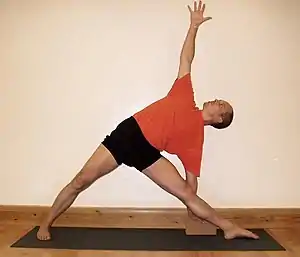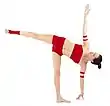Trikonasana
Trikonasana or Utthita Trikonasana (Sanskrit: उत्थित त्रिकोणासन; IAST: utthita trikoṇāsana), [Extended] Triangle Pose is a standing asana in modern yoga as exercise.[1][2] Variations include Baddha Trikonasana (bound triangle pose) and Parivrtta Trikonasana (revolved triangle pose).

Etymology and origins
The name comes from the Sanskrit words utthita (उत्थित), "extended", trikoṇa (त्रिकोण) "triangle",[3] and āsana (आसन) "posture" or "seat".[4]
The pose is first described in the 20th century, appearing in the teaching of Tirumalai Krishnamacharya, including his 1934 book Yoga Makaranda, and in the works of his students.[5]
Description
Trikonasana is performed in two parts, facing left, and then facing right. The practitioner begins standing with the feet one leg-length apart, knees unbent, turns the right foot completely to the outside and the left foot less than 45 degrees to the inside, keeping the heels in line with the hips. The arms are spread out to the sides, parallel to the ground, palms facing down; the trunk is extended as far as is comfortable to the right, while the arms remain parallel to the floor. Once the trunk is fully extended to the right, the right arm is dropped so that the right hand reaches the shin (or a block or on the floor) to the front (left side) of the right foot, with the palm down if flexed. The left arm is extended vertically, and the spine and trunk are gently twisted counterclockwise (i.e., upwards to the left, since they're roughly parallel to the floor), using the extended arms as a lever, while the spine remains parallel to the ground. The arms are stretched away from one another, and the head is often turned to gaze at the left thumb, slightly intensifying the spinal twist. Returning to standing, the bend is then repeated to the left.
Stylistic differences
Different schools of yoga have slightly different views about what trikonasana is and how it should be performed. A 2001 article on the asana in Yoga Journal with instructions given by teachers from five modern yoga traditions (Iyengar Yoga, Ashtanga Vinyasa Yoga, Kripalu Yoga, Sivananda Yoga and Bikram Yoga) showed differing opinions with respect to the body positioning.[6] This article does not make a distinction between trikonasana (triangle pose) and utthita trikonasana (extended triangle pose).
In the tradition of Satyananda Yoga trikonasana is described as a series of up to five different asanas performed in sequence but labeled with the single name "trikonasana".[1][2]

Variations
Variations include:
See also
References
- Swami Muktibodhananda Saraswati (14 December 2006). Energy: The Spark of Life & Universal Goddess, A Book About Yoga and Personal Growth for Men and Women. Trafford Publishing. pp. 63–64. ISBN 978-1-4120-6930-4.
- Saraswati, Swami Satyananda (2004). A Systematic Course in the Ancient Tantric Techniques of Yoga and Kriya. Nesma Books India. pp. 343–345. ISBN 978-81-85787-08-4.
- "Parivritta Trikonasana - AshtangaYoga.info". Retrieved 11 April 2011.
- Sinha, S. C. (1 June 1996). Dictionary of Philosophy. Anmol Publications. p. 18. ISBN 978-81-7041-293-9.
- Mallinson 2017, p. 90.
- "Trikonasana". Yoga Journal: 78–87. 2001.
- "Baddha Trikonasana". Yoga Journal. December 2007: 112. Cite journal requires
|journal=(help) - "Baddha Parivritta Trikonasana / Flickr - Photo Sharing!". Retrieved 13 April 2011.
- Iyengar, B. K. S. (2000). Aṣṭadaḷa yogamālā: collected works. Allied Publishers. p. 32. ISBN 978-81-7764-046-5.
Sources
- Iyengar, B. K. S. (1979) [1966]. Light on Yoga: Yoga Dipika. Unwin Paperbacks. ISBN 978-1855381667.
- Mallinson, James; Singleton, Mark (2017). Roots of Yoga. Penguin Books. ISBN 978-0-241-25304-5. OCLC 928480104.
_from_Jogapradipika_1830_(detail).jpg.webp)
